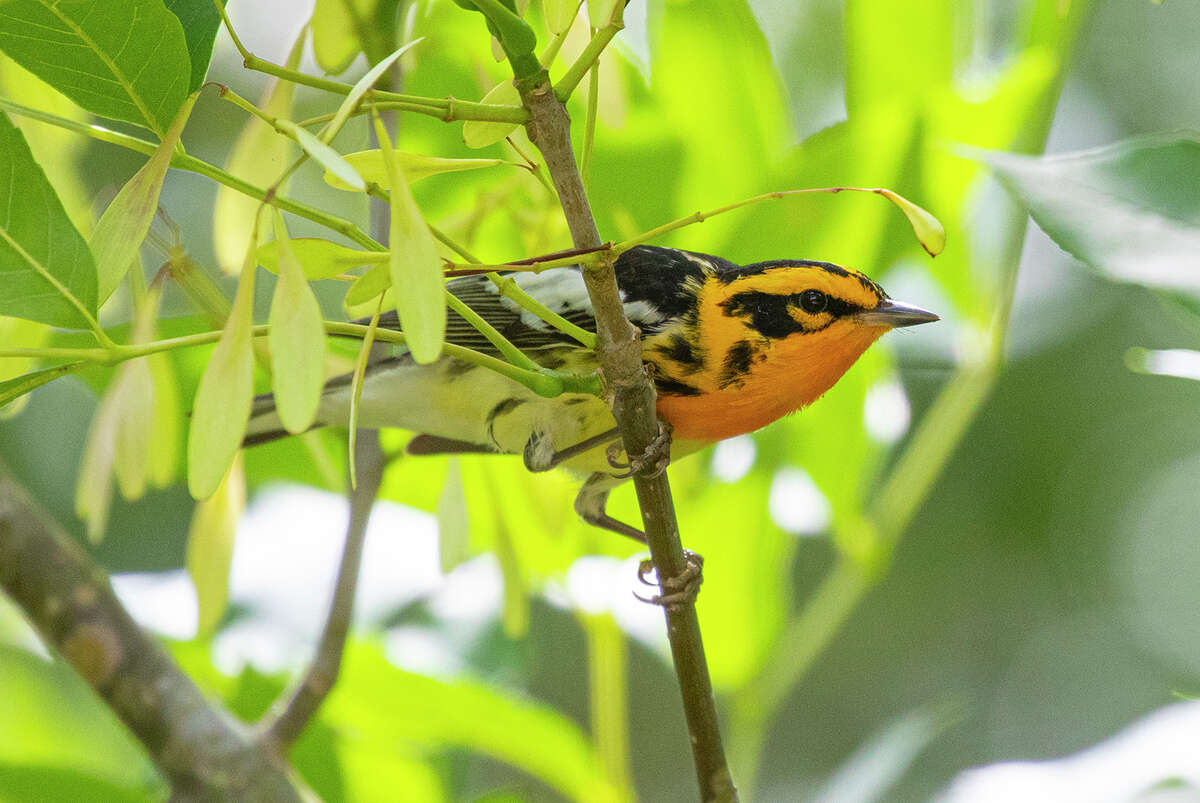Neotropical songbirds arrive in the trees at Houston Audubon's High Island bird sanctuaries during April's migration season
Gary Clark, Correspondent
April 1, 2023
 1of3Blackburnian warblers are arriving on the Upper Texas Coast. They are among the many songbirds that will pass through on their annual spring migration. Photo Credit: Kathy Adams Clark. Restricted use.Kathy Adams Clark/Kathy Adams Clark/KAC Productions 1of3Blackburnian warblers are arriving on the Upper Texas Coast. They are among the many songbirds that will pass through on their annual spring migration. Photo Credit: Kathy Adams Clark. Restricted use.Kathy Adams Clark/Kathy Adams Clark/KAC Productions 
Neotropical songbirds arrive in the trees at Houston Audubon's High Island bird sanctuaries during April's migration season, filling many of us with a sense of childlike wonder.
A child would be awestruck to see a Blackburnian warbler with its flame-colored throat — and be curious about the bird's 4,000-mile migration from its winter home in northern South America.
It's thrilling to see one, even at my age. And despite a lifetime of studying neotropical migratory songbirds such as warblers, tanagers and orioles, I'm as eager as ever to discover other migratory birds arriving at High Island from faraway lands in Latin America.
I've seen the Blackburnian warbler at its winter home in Ecuador. I've gazed out the passenger jet window to see the Central American and Mexican landmass the bird flies over on its way to the Yucatan Peninsula. I've looked down as the plane flies 600 miles over the Gulf of Mexico to the upper Texas Coast, and I've been dumbfounded that the Blackburnian warbler weighing no more than a dollar bill can make the same trans-Gulf flight.
It amazes me how the bird can fly across the Gulf using nothing but winged muscle power, even against howling headwinds from a sudden April cold front. The adult in me knows that untold numbers of Blackburnian warblers and other migratory songbirds will perish at sea during stormy weather and that many reaching land will crash to death against tall lighted buildings or lighted transmission towers.
More Information
MIGRATORY SONGBIRDS
Neotropical songbirds such vireos, thrushes, warblers and tanagers are migrating from the tropics to ancestral breeding grounds in North America.
Particles of magnetite in their heads enable them to orient by compass directions. They also navigate by the stars and sun while also following landmarks such as coastlines, rivers and mountains.
Songbirds migrating overland from Latin America to Texas include the golden-cheeked warbler that arrives from Mexico to breed only in the Texas Hill Country.
Where to see migratory songbirds:
Houston Audubon Society’s bird sanctuaries in High IslandTexas Ornithological Society’s sanctuaries in High Island and Sabine PassGulf Coast Bird Observatory’s sanctuary at Quintana near Freeport
The Blackburnian warbler flies 2,500 miles from Ecuador to the upper Texas Coast. After stopping in bird sanctuaries to rest and fatten up on insects, the bird will fly about one or two thousand miles to breeding grounds in the Great Lakes, New England or Canada's Maritime Provinces.
But I'm still like a child wondering why the bird undertakes such an arduous journey. The answer isn't clear, but scientists believe an innate biological clock compels the bird to migrate. Experiments show that a neotropical songbird confined to a cage will orient itself northward in the spring and southward in the fall.
When the adult in me remembers that neotropical migratory songbirds have drastically declined because of people's depredations of bird habitat, the child in me weeps.
houstonchronicle.com |





 1of3Blackburnian warblers are arriving on the Upper Texas Coast. They are among the many songbirds that will pass through on their annual spring migration. Photo Credit: Kathy Adams Clark. Restricted use.Kathy Adams Clark/Kathy Adams Clark/KAC Productions
1of3Blackburnian warblers are arriving on the Upper Texas Coast. They are among the many songbirds that will pass through on their annual spring migration. Photo Credit: Kathy Adams Clark. Restricted use.Kathy Adams Clark/Kathy Adams Clark/KAC Productions
